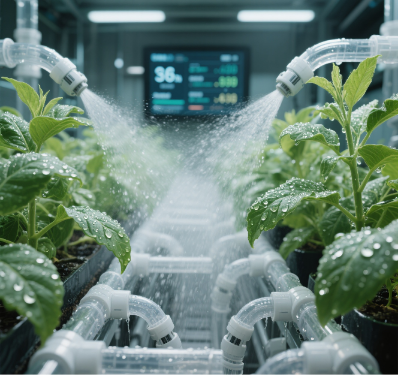In the ever-evolving landscape of modern agriculture, plant factories stand out as a beacon of hope for addressing global food security challenges. These high-tech facilities are characterized by controlled environments, artificial lighting, and precision agriculture techniques. They offer a promising way to produce crops year-round with minimal land and water usage. However, the path to profitability has been difficult, with nearly 90% of China’s plant factories struggling to turn a profit. This article delves into the reasons behind this struggle and explores innovative strategies paving the way for a sustainable future in this emerging industry.
The Surge in Plant Factories: Growth and Technological Advancements
The global push for food security, driven by population growth and urbanization, has accelerated the adoption of plant factories. In 2023 alone, China added 72 new plant factories, bringing the total to 395, with a market value surpassing ¥1.937 billion. Technological advancements have been a key driver of this growth, with notable innovations such as:
- Space Optimization: China Agricultural University introduced movable cultivation racks, doubling space utilization efficiency and reducing land requirements by 50%.
- AI-Powered Farming: Shanghai Jiao Tong University’s AI cultivation system autonomously adjusts growth conditions (light, temperature, and humidity) in real time, enhancing yield by 20-30% and improving resource efficiency by 15-25%.
- Closed-Loop Hydroponics: Companies like Zhejiang’s Ecosystem Team have developed zero-pollution water recycling systems that reduce water waste by 90% and lower operational costs by 12%.
Challenges: Why 90% Struggle to Turn a Profit
Despite advancements, profitability remains a significant challenge for most plant factories. The primary hurdles include:
- Exorbitant energy costs: Traditional plant factories consume around 10 kWh of electricity per kilogram of vegetables, which makes retail prices 2-3 times higher than conventionally grown produce. LED lighting and climate control systems account for over 60% of operational costs, and summer peak electricity bills add further strain.
- Massive Upfront Investments: Building a standard plant factory requires hundreds of millions of yuan for equipment, including multi-layer cultivation racks, automated nutrient delivery systems, and AI-controlled climate systems. Imported LED panels alone cost thousands of yuan per unit, and custom software development adds millions to the total cost.
- Talent Shortages: Plant factories require expertise in plant physiology, environmental engineering, and automation. A China Agricultural University survey revealed that 70% of plant factories face talent shortages. This forces companies to invest heavily in training or compete for limited specialist talent, increasing labor costs by 15-20%.
Innovative Business Models Driving Success
A new wave of agricultural innovators is breaking down barriers with five groundbreaking models supported by compelling data.
- Aquaponics and circular farming: A 43-acre aquaponics plant in Jiangxi combines fish farming and vegetable cultivation. Using laser-assisted lighting, it reduces energy consumption by 30%. This model achieves five times the output of traditional farming and generates an annual income of ¥10 million.
- Direct-to-Consumer “Order Farming”: A smart farm in Xinjiang delivers fresh produce, such as strawberries and lettuce, to supermarkets in Hangzhou within 36 hours via cold-chain logistics. This ensures stable demand and premium pricing. In just six months, the farm earned ¥1.24 million, with repeat customer rates exceeding 60%.
- Value-Added Processing: A plant factory in Hunan processes yellow hollyhock flowers into high-margin extracts used in cosmetics and medicines. This boosts farmers’ income to ¥3,000–4,000 per acre, which is a 200–300% increase compared to traditional cultivation.
- Technology Export and Licensing: Shanghai Jiao Tong’s “Berry Cube” team sells its AI farming algorithms globally, generating ¥8 million in license fees annually. Zhejiang’s “Ecosystem Team” exports hydroponic technology to New Zealand and Qatar, securing contracts worth ¥15 million in 2024.
- Agri-Tourism & Education: A plant factory in Wuxi offers pick-your-own experiences and agricultural workshops, increasing revenue through ticket sales and brand loyalty. Tourism-related income accounted for 35% of total profits in 2024, surpassing initial projections by 20%.
Key Breakthroughs for Future Growth
Three technological and strategic advancements are expected to promote sustainable growth.
- Energy Efficiency Innovations: OPPLE’s “Smart Berry Team” reduced lighting costs by 34% using precise LED targeting. 2. CyberFarmer’s cooling system reduced air conditioning energy use by 40% and tripled water efficiency, saving ¥500,000 annually for a medium-sized plant factory.
- Vertical Integration and Industry Collaboration: The “government + enterprise + farmer” model in Xinjiang increased profit margins by 25% through subsidized infrastructure and shared logistics. Processing-focused chains in Hunan achieved 18% higher returns by integrating cultivation, packaging, and distribution.
- Global Expansion: Chinese firms like Sino-Agri LED are exporting AI-controlled plant factories to Saudi Arabia, where energy costs are up to 40% cheaper than in China and demand for premium produce is high. By 2025, exports are projected to reach ¥500 million, accounting for 20% of total revenue.
A Quiet Revolution in Agriculture
Plant factories represent a silent agricultural revolution, blending cutting-edge technology with innovative business models. Although challenges remain, improvements in energy efficiency, supply chain integration, and global market expansion are paving the way for profitability. As China continues to refine these approaches, plant factories may soon transition from niche experiments to mainstream agricultural powerhouses, reshaping the future of food production worldwide. With 395 operational facilities (up 22% since 2022) and an expected market value of over ¥3 billion by 2026, China’s plant factories are addressing food security and rewriting the rules of modern agriculture.









